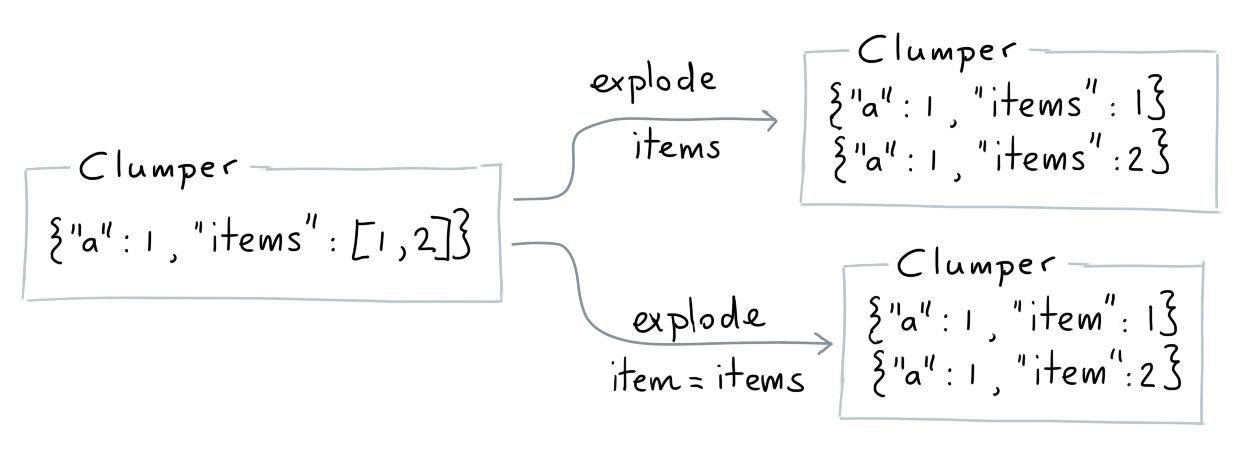Nested Data
Because sequences of nested data really come in all sorts of shapes and sizes this library offers verbs to help you reshape the data into different formats. This document will demonstrate how these verbs work.
Explode¶
Sometimes you'll have data that is nested as a list of values.
If you'd like to expand such a list of values you can use
.explode().

from clumper import Clumper
data = [{'a': 1, 'items': [1, 2]}]
clumper = Clumper(data).explode("items")
assert clumper.equals([{'a': 1, 'items': 1}, {'a': 1, 'items': 2}])
new_data = Clumper(data).explode(item="items").collect()
assert clumper.equals([{'a': 1, 'item': 1}, {'a': 1, 'item': 2}])
Note how the syntax allows you to either explode the values, assigning them to the old keyname or to directly rename this field. You can also pass multiple keys in a single command.
from clumper import Clumper
data = [{'a': 1, 'items': [1, 2], 'values':[3, 4]}]
clumper = Clumper(data).explode("items", "values")
expected = [
{'a': 1, 'items': 1, 'values': 3},
{'a': 1, 'items': 1, 'values': 4},
{'a': 1, 'items': 2, 'values': 3},
{'a': 1, 'items': 2, 'values': 4}
]
assert clumper.equals(expected)
new_data = Clumper(data).explode(item="items", val="values").collect()
expected = [
{'a': 1, 'item': 1, 'val': 3},
{'a': 1, 'item': 1, 'val': 4},
{'a': 1, 'item': 2, 'val': 3},
{'a': 1, 'item': 2, 'val': 4}
]
assert clumper.equals(expected)
Unpack¶
The unpack verb is very similar to explode but here we expect a list of
dictionaries as opposed to a list of values.

from clumper import Clumper
list_dicts = {
'a': 1,
'rows': [{'b': 2, 'c': 3}, {'b': 3}, {'b': 4}]
}
result = Clumper(list_dicts).unpack('rows').collect()
expected = [
{'a': 1, 'b': 2, 'c': 3},
{'a': 1, 'b': 3},
{'a': 1, 'b': 4}
]
assert result == expected
Single Dictionaries¶
Sometimes you're dealing with json data that isn't a list of dictionaries. You
should be aware that you may want to read in the data differently. You can keep
the data as a dictionary or automatically wrap it as a list by tweaking the listify
parameter. This is available on every .read_<format>-method.
Listify = True¶
from clumper import Clumper
example1 = Clumper.read_yaml("tests/data/demo-nested.yml")
expected1 = [
{
'nested1': [
{'item': 1, 'value': 'a'},
{'item': 2, 'value': 'b'},
{'item': 3, 'value': 'c'}
],
'nested2': [
{'item': 1, 'value': 'a'},
{'item': 2, 'value': 'b'},
{'item': 3, 'value': 'c'}
]
}
]
assert example1.equals(expected1)
Listify = False¶
from clumper import Clumper
example2 = Clumper.read_yaml("tests/data/demo-nested.yml", listify=False)
expected2 = {
'nested1': [
{'item': 1, 'value': 'a'},
{'item': 2, 'value': 'b'},
{'item': 3, 'value': 'c'}
],
'nested2': [
{'item': 1, 'value': 'a'},
{'item': 2, 'value': 'b'},
{'item': 3, 'value': 'c'}
]
}
assert example2.equals(expected2)
Flatten Keys¶
In the "list-like dictionary" scenarios you might want to use .flatten_keys.
This method flattens the keys in the data.

from clumper import Clumper
data = {
'feature_1': {'propery_1': 1, 'property_2': 2},
'feature_2': {'propery_1': 3, 'property_2': 4},
'feature_3': {'propery_1': 5, 'property_2': 6},
}
expected = [
{'propery_1': 1, 'property_2': 2, 'key': 'feature_1'},
{'propery_1': 3, 'property_2': 4, 'key': 'feature_2'},
{'propery_1': 5, 'property_2': 6, 'key': 'feature_3'}
]
assert Clumper(data, listify=False).flatten_keys().collect() == expected
Show¶
Getting the verbs right can be trick. So we've also added a show verb which
can be useful while debugging. It requires rich to be manually installed beforehand
if you want to see the pretty colors in the output.
from clumper import Clumper
data = [{"n": 123, "data": [1, 2, 3], "maintainer": "Vincent"}]
Clumper(data).show("Before", n=1).explode("data").show("After", n=3)
